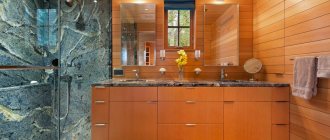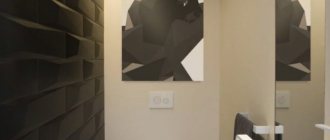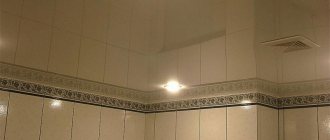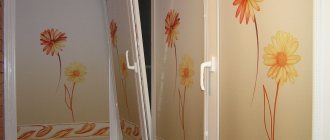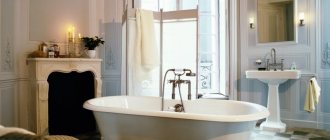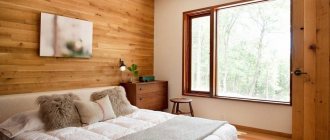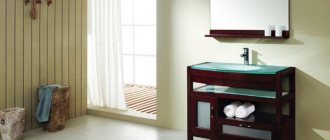Features of wood-look tile design
- In order for the floor covering to be especially reliable, it is better to choose more durable products with a matte surface. If ceramics are used, it must have a high level of moisture resistance and anti-slip properties.
- When choosing grout, its color does not have to match the tone of the tile. Contrasting seams will further highlight the appearance of the finish and make it more impressive.
- When decorating a small bathroom, you should use cladding in light colors, for example, ash, maple or bleached oak with almost imperceptible relief. This way you can add visual space to the room.
Finishing options with other wood-like materials
Natural materials are far from the only way to design a wood-look bathroom. Many finishing materials are produced that imitate the color and texture of wood, but at the same time have better performance characteristics, for example, tiles or moisture-resistant MDF panels. They are more adapted to the effects of dampness, chemicals and mold, are practically not deformed and have a long service life.
Ceramic tiles are especially practical: they are difficult to damage, they are durable, and there are options with a non-slip coating. In addition, finishing a bathroom with tiles will cost less than wood. Modern manufacturers produce ceramics that are difficult to visually distinguish from real wood.
If it is decided that substitutes will be used instead of natural material, you need to approach their choice wisely:
- To create an atmosphere of comfort, a finish is used that is as close as possible to real wood, i.e. it is advisable to purchase tiles or panels in natural tones.
- The texture of the materials will complement the effect. In addition, the rough tiles will prevent your feet from slipping.
- A parquet or laminate pattern looks good on the floor. On the walls there is a simple imitation of boards.
You can combine materials: for example, lay the floor and walls with tiles, and cover the ceiling with panels.
Which tile is better to choose for the bathroom?
Several types of tile finishes:
- Ceramic (tile). In its production, natural materials are used, such as clay and sand with the addition of special components that improve the structure. There are unglazed and glazed tiles, which have a longer service life, durability, resistance to ultraviolet radiation and temperature changes.
- Porcelain tiles. It can perfectly imitate any type of wood and is quite durable and resistant to low temperatures. The composition of porcelain stoneware includes white clay and sand with natural dyes.
- Quartz vinyl. The main component of such facing tiles is quartz sand with the addition of various impurities. The tile has a certain flexibility and a high degree of comfort, as it is quite warm.
The photo shows a dark wood-look ceramic tile finish in the bathroom interior.
Features of using natural wood in the bathroom
A bathroom is a damp room that places specific demands on the quality of finishing. On the one hand, you need it to be warm and comfortable. In this case, it is better to use natural wood. But due to dampness, the material is susceptible to accelerated rotting, mold and deformation. Certain types of wood are resistant to this effect:
Therefore, when purchasing, attention is paid to the quality of the material, breed and correct processing.
Important! Each wooden element must be treated with special compounds that protect the coating from exposure to dampness.
The nuances of processing wood that will be used in the bathroom:
- The wood must be sanded, impregnated with an antifungal compound, varnish or special wax.
- If desired, you can go over the surface with stain; this product changes the color of the coating.
- If natural material is oiled, it will become more resistant to mechanical damage and acquire some shine.
In a small bathroom it is better to use light-colored wood.
Below are interesting ideas, photos and valuable tips for decorating a bathroom.
What can be tiled in a bathroom?
The most popular design options.
Wood effect wall tiles
Wall tiles imitating wood print, texture and embossing, thanks to their easy care and beautiful appearance, are perfect for implementing a wide variety of design ideas.
The photo shows a bathroom with a wall lined with wood tiles.
On the floor
For finishing the floor, the best option would be durable porcelain stoneware. Due to its rectangular shape and relief texture, it looks no different from natural wood and resembles a parquet floorboard.
The photo shows dark brown wood-look wall and floor tiles in a bathroom interior.
Tabletop
Tile clinker finishing or mosaic with a realistic imitation allows you to give the countertop with a sink an aesthetic and very neat appearance.
Shower cabin
In the design of the shower, glossy or matte cladding is used, which allows you to create a small sauna in the bathroom. For the pallet, rectangular tiles are often used, which imitate a parquet board.
Bathroom screen
The bathroom screen is decorated either with a dark finish simulating tropical wood, or with a light finish that creates a warmer atmosphere in the room. Due to their indistinguishable natural texture, such products will become a spectacular interior element that will attract attention.
Ceiling
Thanks to this ceiling finish, it is possible to maintain the aesthetics of the bathroom for a long time. For example, most often they use glazed ceramics, which have a special protective layer and are not afraid of moisture and hot steam.
The photo shows the ceiling in the bathroom, decorated with light-colored wood tiles.
Popular manufacturers
The use of wood-effect tiles in bathroom interiors is popular, so in hardware stores you can find products from manufacturers from around the world and in any price category.
Well-established and trusted companies include:
- Kerama Marazzi (Russia). It produces porcelain stoneware using dry pressing technology, which most accurately replicates the texture of natural material. The manufacturer’s assortment includes more than 2 thousand types of tiles, as well as collections with an emphasis on the characteristics and style of individual countries.
- Cersanit (Poland). The company produces not only finishing materials, but also furniture and bathroom accessories.
- Fanal and Porcelanosa (Spain). Companies whose products are recognized throughout the world as the most durable and durable. A special feature of cladding from these manufacturers is the use of large inclusions, spraying and relief elements on a plain surface.
- Fap Ceramiche (Italy). Produces luxury finishing materials for high-income people. Tiles with imitation of natural materials are the main activity of the company.
A bathroom with wood-effect tiles has a unique look and will bring aesthetic pleasure to its owners for many years. The compatibility of this material with others makes it possible to implement design solutions in almost any style.
Wood imitation tile layout
There are many types of tile installation, among which the most notable is the herringbone arrangement, which involves the use of one, two or three narrow tiles, and also provides the opportunity to combine several products with different wood textures or shade solutions.
The diagonal layout not only harmonizes the decor and gives the interior style and unusualness, but also visually expands the space, and laying hog tiles in a running pattern is a very interesting and original option, with which you can get away from the traditional design of the bathroom.
The photo shows multi-colored wood-look tiles with a diagonal herringbone pattern on the floor in a bathroom interior.
How to lay wood-look tiles
There are different ways to install wood cladding:
- Deck (“staggering”). The tiles are laid with a row offset by 1/5 or 1/6 of the length of the tile itself. The drawing can also be laid out diagonally. This technique is suitable for both walls and flooring. The amount of waste will be minimal. You can lay the tiles in this way yourself, without resorting to the services of a specialist.
- "Herringbone" or parquet assembly. The dies are laid to each other at an angle of 90° and at 45° in relation to the walls, imitating the position of the paws of spruce trees. This pattern looks impressive in a classic interior if narrow tiles of different shades or wood textures are used. Variants of this installation are “double herringbone”, when two dies are placed in pairs, and “French herringbone” - three dies are laid out.
- Checkerboard - the resulting pattern resembles a chessboard. The chessboard is placed horizontally, vertically or diagonally. You can alternate not only different colors, but also different textures. The checkerboard pattern can be combined with other masonry techniques. For example, make a checkerboard pattern in the center of the floor, and deck cladding on the sides.
- “Braiding” - creates an imitation of weaving wood veneer. This is the most difficult tiling technique, since it is necessary not only to lay the tiles in the desired order, but also to place the fibers of the pattern in one direction.
- “Well” or parquet wicker is a more impressive wicker with a three-dimensional visual effect. It comes in three types:
- homogeneous - lay dies of the same color and pattern;
- a wickerwork in which the central square is made of tiles imitating one type of wood, and the dies around them are of a contrasting color;
- braided tiles with different textures of three types of wood.
Laying rules
Regardless of the chosen installation method, you should adhere to the general rules of cladding:
- Before starting work, the surface must be thoroughly cleaned and made smooth. To do this, putty is applied to the walls or sheathed with plasterboard, and a screed is made on the floor. Cover the surfaces with a primer or apply a special mastic for greater waterproofing.
- The cladding begins from the far corner towards the front door. Using a building level, markings are made, beating off reference lines. This makes it possible to control at each stage whether the rows remain even.
- To work you will need a trowel and glue. The back surface of the tile is moistened, glue is applied to it with a trowel and applied to the surface. To ensure that the seams between the dies are the same, plastic crosses are used.
- After finishing the cladding and the glue has dried, the seams are sealed with a special grout mixture. It can be tone on tone with tiles or a contrasting color.
Tile color with wood texture, beige, wenge
Wood-look tiles in brown and beige tones are considered especially popular. Also, the finish can have shades of exotic expensive wood species, for example, wenge, mahogany or rosewood, which will be more appropriate in spacious bathrooms.
When using white or gray products, the design of the room is filled with special expressiveness, aesthetic brevity and elegance.
The photo shows the walls and floor in the bathroom with gray wood-look tiles.
Bathroom made of stone - tips for choosing, design examples and nuances of caring for the material (95 photos)
The bathroom is an important attribute in the home of a modern person. Its design can be developed in different variations. From the simplest to the most sophisticated. The same is true with the choice of sanitary products. You can arrange your bathroom to suit every taste. There are simply a huge number of variations of bathtubs.
Until very recently, there was only one option on the market - cast iron. And now there are none. Bathtubs made of artificial stone have taken their place in human life.
There are a huge number of designer stone bathtubs and not only bathtubs. There is already a huge selection of sinks and showers on the market. If possible, you can make yourself a complete stone finish in the bathroom.
Photo of tiles in the interior of the toilet
Due to the correct and neat design of surfaces, the interior of the toilet acquires not only a neat, but also a more thoughtful appearance. Wood cladding is a practical solution, easy to maintain and allows you to give the environment homeliness, comfort and at the same time elegance and respectability.
See also toilet tiling ideas.
The photo shows the interior of the bathroom, decorated with wall and floor tiles with imitation wood.
Also, using tile material, you can visually adjust the dimensions of a small and narrow toilet, for example, use floor finishing with a diagonal layout or use rectangular wall tiles laid in a horizontal or vertical direction.
Wooden bathroom, practical tips on using various materials.
Wood is considered the oldest and therefore the most familiar material for us not only in construction, but also in decorating premises. The interior, decorated with wood, is natural and environmentally friendly, therefore it is welcomed by many owners of apartments and houses.
It is very important that wood can be used not only in living quarters, but also in the bathroom. The stereotype that wood and moisture are incompatible has long been debunked by our sailor ancestors, who plied the waters on their sailboats. The secret to the durability of wood lies in special processing.
Treating wood with varnish or other special compounds allows you to extend the life of furniture and other decor. It is only important to treat this issue responsibly. Another nuance is the choice of products for the bathroom interior, made from special varieties of wood and resistant to moisture.
What can you combine wood-look tiles with?
Wood-look tiles harmoniously combine with a wide variety of finishing materials, such as plastic, wallpaper, metal, brick, concrete, natural stone, marble or regular tiles.
The photo shows a combination of wood-effect tile cladding with a concrete surface in a bathroom interior.
Combining wood-effect tiles with marble is a win-win option that allows you to create an elegant, luxurious and noble design. By combining these products that imitate wood with regular tiles, it is possible to create a more restrained interior and a comfortable place for relaxation.
Composition and manufacturing process
A huge number of materials exist for making artificial stone bathtubs. For example, granite or marble, these are all artificial stones.
For production, granite chips or special resin are used. More than half of the substance in the source material is minerals.
You will also need a catalyst for production. Its function will be the main one. Thanks to it, the product will eventually harden and keep its shape.
Then the burning process occurs. For this, high temperatures are used, more than 1000 degrees.
Initially, the material has a liquid-like state, and after 24 hours it hardens. When the product is removed from the mold, it is not quite ready for use. It takes a little more time for everything to harden.
To understand the beauty of the appearance of such products, you should turn to the Internet. Fortunately, there are a huge number of photos of a stone bathroom on the World Wide Web.
To some extent, the products have an aristocratic appearance. The spirit of the Middle Ages seems to be in such design solutions.
The 15th century, castles, luxurious balls immediately appear before your eyes. A room with such a design is transformed, the appearance becomes “richer”. Luxury is truly the right word. There are no other epithets here.
Design ideas for wood-effect tiles in the interior of a room
To give the bathroom interior a calm look, use a matte finish, which provides an ideal neutral background. In addition, water stains are less visible on it, which makes it quite practical. When creating a more eye-catching design, products with a glossy sheen or decorated ceramics are used.
The photo shows a bathroom with light tiles imitating aged wood on the wall.
An aged wood paneling with a printed or actual textured raised surface is sure to attract attention and add a certain sophistication to the entire setting.
Choosing tiles for a white bathroom
Also, don’t be too simple when choosing white tiles. Despite its apparent simplicity, it can be completely different, while creating a unique effect.
It is worth considering that the tiles may differ in tone:
- bright white;
- grey-white;
- creamy;
- lactic.
The tiles in a white bathroom may differ in color.
For example, in the Scandinavian style you should choose white tiles with a slight shade of gray or blue notes. A bright white color would be rather inappropriate here - it would be better suited for a high-tech or modern style.
The texture of the tile is also an important factor. It can be either matte or glossy. In addition, it can imitate different surfaces, from mosaic to stone.
Examples of bathroom design in different styles
A similar design with imitation wood species would be appropriate for eco-design or interiors in African, Oriental and ethnic styles.
The photo shows tiled cladding of walls and podium in the interior of a bathroom made in eco-style.
Also, this finishing type is often found in bathrooms designed in Scandinavian, classic and modern styles or is used to transform the bathroom into a rustic country-style bathhouse.
Cool ideas for decorating bathrooms and toilets with wood
Scandinavian style looks impressive, and wood in the bathroom interior looks even cooler. We present an overview of 10 such finishing options:
Toilet on the attic floor Source design-homes.ru
- The dream of many is a bathroom decorated with wood, located on the attic floor.
Country style Source hihetetlen2.rssing.com/
- A combination of rustic style, executed in an unpretentious, at first glance, rustic genre.
Interior of a combined bathroom with wood effect Source www.houzz.de
- Small bathroom. Eco style.
Exposed beams Source mrsw.co.uk/
- Combination of wood and stone in the bathroom interior.
Bathroom in a country house Source muravel.ru/
- Spa-style room made of clapboard and ceramic tiles.
Bathroom in a log house Source interier.zzz.com.ua/
- Small bathroom of a wooden house.
Bathroom in loft style Source www.0412.ua
- Modern bathroom, chalet style.
Wood decoration Source www.spatiulconstruit.ro
- Strict modern classics.
Light wood Source vip-1gl.ru
- A room decorated with imitation timber.
Bathroom interior in a wooden house Source kb.blackbookvillas.com/
- Wenge in combination with stained timber.
Recommendations for proper care of a white bathtub
To make your bathroom look as beautiful as in the photo, interior decorating experts give the following tips for cleaning a snow-white bathroom:
- so that the surfaces decorated with tiles and the bath itself do not lose their snow-white color, after each bath they wipe them dry with a clean cloth;
- all horizontal planes are wiped clean of dust every day;
- to prevent mold from settling in the tile joints, a special sealant is used during installation;
- Light-colored tiles can be washed with soapy water or specialized household chemicals intended for tiles;
- to give the tiles shine, just add a couple of drops of ammonia to the water and wash the wall with the solution;
- It’s easy to make the tile joints white - to do this, wipe them with a cloth and chalk;
- do not wash a snow-white bathtub with acid-containing products - they will quickly destroy the enamel, turning the surface gray;
- to remove rust stains, use special products, but regular laundry bleach will also help;
- the ceiling, walls of the room are cleaned of dust with a vacuum cleaner, brush, with a rag wrapped around it;
- To ensure that water pipes do not lose their whiteness under the influence of water, they are carefully sealed and wiped with a dry cloth when condensation appears.
Accessories, textiles as bathroom decor
Suitable accessories for a white bathroom will be both snow-white and contrasting elements. This is one or several mirrors in white frames or completely without them, shiny heated towel rails and decorative supports for the sink, handrails for the bathroom and its curly legs in the form of animal paws.
If there is a window in the room, live plants that can live in conditions of high humidity and temperature changes are placed here. When there are no windows, it is permissible to install a false false window depicting a beautiful landscape, preferably a winter one. This is an additional light source that visually slightly expands the space.
Accessories include:
- dispenser jars for liquid soap;
- hanging plastic cabinets for cosmetic accessories;
- soap dishes;
- hangers, hooks for towels and washcloths;
- dryers and laundry baskets;
- bath and floor mats;
- toilet brushes;
- cornices;
- toilet paper holders;
- cups for toothbrushes.
If the room is of sufficient size, it can be easily furnished with stools and tables.
Towels, bathroom curtains, washcloths, and body sponges are purchased in white. If you want to create a two- or three-color interior, then all small objects are chosen to be contrasting.
Advice: if small children live in the apartment, the bathhouse environment is complemented by a children’s bathtub, a special “slide” for it, small rubber mats, and a water thermometer made in the shape of an animal or fish.


